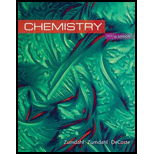
Concept explainers
The nitrogen content of organic compounds can be determined by the Dumas method. The compound in question is first reacted by passage over hot CuO(s):
The product gas is then passed through a concentrated solution of KOH to remove the CO2. After passage through the KOH solution, the gas contains N2 and is saturated with water vapor. In a given experiment a 0.253-g sample of a compound produced 31.8 mL N2 saturated with water vapor at 25°C and 726 torr. What is the mass percent of nitrogen in the compound? (The vapor pressure of water at 25°C is 23.8 torr.)
Trending nowThis is a popular solution!

Chapter 5 Solutions
Chemistry
- According to the Resource Conservation and Recovery Act (RCRA), waste material is classified as toxic and must be handled as hazardous if the lead concentration exceeds 5 mg/L. By adding chloride ion, the lead ion will precipitate as PbCl2, which can be separated from the liquid portion. Once the lead has been removed, the rest of the waste can be sent to a conventional waste treatment facility. How many grams of sodium chloride must be added to 500 L of a waste solution to reduce the concentration of the Pb2+ ion from 10 to 5 mg/L?arrow_forwardUse the appropriate tables to calculate H for (a) the reaction between copper(II) oxide and carbon monoxide to give copper metal and carbon dioxide. (b) the decomposition of one mole of methyl alcohol (CH3OH) to methane and oxygen gases.arrow_forwardWrite a chemical equation for each process and classify each as reactant-favored or product-favored. (a) A puddle of water evaporates on a summer day. (b) Silicon dioxide (sand) decomposes to the elements Silicon and oxygen. (c) Paper, which is mainly cellulose (C6H10O5)n, bums at a temperature of 451 F. (d) A pinch of sugar dissolves in water at room temperature.arrow_forward
- Should heat be added as a reactant or as a product to each of the following equations for chemical reactions based on the given thermicity for the reaction? a. 2SO2 + O2 2SO3 (exothermic) b. N2 + O2 2NO (endothermic) c. CH4 + 2O2 CO2 + 2H2O (exothermic) d. 2H2O + 2Cl2 4HCl + O2 (endothermic)arrow_forwardOne of the components of polluted air is NO. It is formed in the high-temperature environment of internal combustion engines by the following reaction: N2(g)+O2(g)2NO(g)H=180KJ Why are high temperatures needed to convert N2 and O2 to NO?arrow_forwardThe hydrocarbon naphthalene was frequently used in mothballs until recently, when it was discovered that human inhalation of naphthalene vapors can lead to hemolytic anemia. Naphthalene is 93.71% carbon by mass, and a 0.256-mole sample of naphthalene has a mass of 32.8 g. What is the molecular formula of naphthalene? This compound works as a pesticide in mothballs by. sublimation of the .solid so that it fumigates enclosed spaces with its vapors according to the equation Naphthalene(s)naphthalene(g)K=4.29106(at298K) If 3.00 g solid naphthalene is placed into an enclosed space with a volume of 5.00 L at 25C, what percentage of the naphthalene will have sublimed once equilibrium bas been established?arrow_forward
- Silicon forms a series of compounds analogous to the al-kanes and having the general formula SinH2n+2. The first of these compounds is silane, SiH4, which is used in the electronics industry to produce thin ultrapure silicon films. SiH4(g) is somewhat difficult to work with because it is py-ropboric at room temperature—meaning that it bursts into flame spontaneously when exposed to air. (a) Write an equation for the combustion of SiH4(g). (The reaction is analogous to hydrocarbon combustion, and SiO2 is a solid under standard conditions. Assume the water produced will be a gas.) (b) Use the data from Appendix E to calculate ? for this reaction. (c) Calculate G and show that the reaction is spontaneous at 25°C. (d) Compare G for this reaction to the combustion of methane. (See the previous problem.) Are the reactions in these two exercises enthalpy or entropy driven? Explain.arrow_forwardWet limestone is used to scrub SO2 gas from the exhaust gases of power plants. One possible reaction gives hydrated calcium sulfite: CaCO3(s) + SO2(g) + H2O() CaSO3 H2O(s) + CO2(g) Another reaction gives hydrated calcium sulfate: CaCO3(s) + SO2(g) + H2O() + O2(g) CaSO4 H2O(s) + CO2(g) (a) Which reaction is more product-favored at equilibrium? Use the data in the table below and any other information needed in Appendix L to calculate rG for each reaction at 25 C. (b) Calculate rG for the reaction CaSO3 H2O(s) + O2(g) CaSO4 H2O(s) Is this reaction product- or reactant-favored at equilibrium?arrow_forward
 Chemistry & Chemical ReactivityChemistryISBN:9781337399074Author:John C. Kotz, Paul M. Treichel, John Townsend, David TreichelPublisher:Cengage Learning
Chemistry & Chemical ReactivityChemistryISBN:9781337399074Author:John C. Kotz, Paul M. Treichel, John Townsend, David TreichelPublisher:Cengage Learning Chemistry for Engineering StudentsChemistryISBN:9781337398909Author:Lawrence S. Brown, Tom HolmePublisher:Cengage Learning
Chemistry for Engineering StudentsChemistryISBN:9781337398909Author:Lawrence S. Brown, Tom HolmePublisher:Cengage Learning Chemistry & Chemical ReactivityChemistryISBN:9781133949640Author:John C. Kotz, Paul M. Treichel, John Townsend, David TreichelPublisher:Cengage Learning
Chemistry & Chemical ReactivityChemistryISBN:9781133949640Author:John C. Kotz, Paul M. Treichel, John Townsend, David TreichelPublisher:Cengage Learning Chemistry: The Molecular ScienceChemistryISBN:9781285199047Author:John W. Moore, Conrad L. StanitskiPublisher:Cengage Learning
Chemistry: The Molecular ScienceChemistryISBN:9781285199047Author:John W. Moore, Conrad L. StanitskiPublisher:Cengage Learning ChemistryChemistryISBN:9781305957404Author:Steven S. Zumdahl, Susan A. Zumdahl, Donald J. DeCostePublisher:Cengage Learning
ChemistryChemistryISBN:9781305957404Author:Steven S. Zumdahl, Susan A. Zumdahl, Donald J. DeCostePublisher:Cengage Learning Chemistry: An Atoms First ApproachChemistryISBN:9781305079243Author:Steven S. Zumdahl, Susan A. ZumdahlPublisher:Cengage Learning
Chemistry: An Atoms First ApproachChemistryISBN:9781305079243Author:Steven S. Zumdahl, Susan A. ZumdahlPublisher:Cengage Learning





